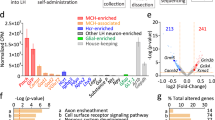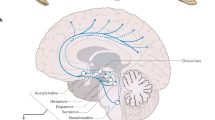Abstract
Orexins are hypothalamic peptides that play an important role in maintaining wakefulness in mammals. Permanent deficit in orexinergic function is a pathophysiological hallmark of rodent, canine and human narcolepsy. Here we report that in rats, dogs and humans, somnolence is induced by pharmacological blockade of both orexin OX1 and OX2 receptors. When administered orally during the active period of the circadian cycle, a dual antagonist increased, in rats, electrophysiological indices of both non-REM and, particularly, REM sleep, in contrast to GABAA receptor modulators; in dogs, it caused somnolence and increased surrogate markers of REM sleep; and in humans, it caused subjective and objective electrophysiological signs of sleep. No signs of cataplexy were observed, in contrast to the rodent, dog or human narcolepsy syndromes. These results open new perspectives for investigating the role of endogenous orexins in sleep-wake regulation.
This is a preview of subscription content, access via your institution
Access options
Subscribe to this journal
Receive 12 print issues and online access
$209.00 per year
only $17.42 per issue
Buy this article
- Purchase on Springer Link
- Instant access to full article PDF
Prices may be subject to local taxes which are calculated during checkout





Similar content being viewed by others
References
de Lecea, L. et al. The hypocretins: hypothalamus-specific peptides with neuroexcitatory activity. Proc. Natl. Acad. Sci. USA 95, 322–327 (1998).
Sakurai, T. et al. Orexins and orexin receptors: a family of hypothalamic neuropeptides and G protein-coupled receptors that regulate feeding behavior. Cell 92, 573–585 (1998).
Peyron, C. et al. Neurons containing hypocretin (orexin) project to multiple neuronal systems. J. Neurosci. 18, 9996–10015 (1998).
Nambu, T. et al. Distribution of orexin neurons in the adult rat brain. Brain Res. 827, 243–260 (1999).
Kilduff, T.S. & Peyron, C. The hypocretin/orexin ligand-receptor system: implications for sleep and sleep disorders. Trends Neurosci. 23, 359–365 (2000).
Lee, M.G., Hassani, O.K. & Jones, B.E. Discharge of identified orexin/hypocretin neurons across the sleep-waking cycle. J. Neurosci. 25, 6716–6720 (2005).
Taheri, S. et al. Diurnal variation in orexin A immunoreactivity and prepro-orexin mRNA in the rat central nervous system. Neurosci. Lett. 279, 109–112 (2000).
Yoshida, Y. et al. Fluctuation of extracellular hypocretin-1 (orexin A) levels in the rat in relation to the light-dark cycle and sleep-wake activities. Eur. J. Neurosci. 14, 1075–1081 (2001).
Kiyashchenko, L.I. et al. Release of hypocretin (orexin) during waking and sleep states. J. Neurosci. 22, 5282–5286 (2002).
Martinez, G.S., Smale, L. & Nunez, A.A. Diurnal and nocturnal rodents show rhythms in orexinergic neurons. Brain Res. 955, 1–7 (2002).
Salomon, R.M. et al. Diurnal variation of cerebrospinal fluid hypocretin-1 (orexin-A) levels in control and depressed subjects. Biol. Psychiatry 54, 96–104 (2003).
Zeitzer, J.M. et al. Circadian and homeostatic regulation of hypocretin in a primate model: implications for the consolidation of wakefulness. J. Neurosci. 23, 3555–3560 (2003).
Desarnaud, F. et al. The diurnal rhythm of hypocretin in young and old F344 rats. Sleep 27, 851–856 (2004).
Hagan, J.J. et al. Orexin A activates locus coeruleus cell firing and increases arousal in the rat. Proc. Natl. Acad. Sci. USA 96, 10911–10916 (1999).
Bourgin, P. et al. Hypocretin-1 modulates rapid eye movement sleep through activation of locus coeruleus neurons. J. Neurosci. 20, 7760–7765 (2000).
Piper, D.C., Upton, N., Smith, M.I. & Hunter, A.J. The novel brain neuropeptide, orexin-A, modulates the sleep-wake cycle of rats. Eur. J. Neurosci. 12, 726–730 (2000).
Espana, R.A., Baldo, B.A., Kelley, A.E. & Berridge, C.W. Wake-promoting and sleep-suppressing actions of hypocretin (orexin): basal forebrain sites of action. Neuroscience 106, 699–715 (2001).
Kiyashchenko, L.I., Mileykovskiy, B.Y., Lai, Y.Y. & Siegel, J.M. Increased and decreased muscle tone with orexin (hypocretin) microinjections in the locus coeruleus and pontine inhibitory area. J. Neurophysiol. 85, 2008–2016 (2001).
Ishibashi, M. et al. Effects of orexins/hypocretins on neuronal activity in the paraventricular nucleus of the thalamus in rats in vitro. Peptides 26, 471–481 (2005).
Lambe, E.K., Olausson, P., Horst, N.K., Taylor, J.R. & Aghajanian, G.K. Hypocretin and nicotine excite the same thalamocortical synapses in prefrontal cortex: correlation with improved attention in rat. J. Neurosci. 25, 5225–5229 (2005).
Mileykovskiy, B.Y., Kiyashchenko, L.I. & Siegel, J.M. Behavioral correlates of activity in identified hypocretin/orexin neurons. Neuron 46, 787–798 (2005).
Estabrooke, I.V. et al. Fos expression in orexin neurons varies with behavioral state. J. Neurosci. 21, 1656–1662 (2001).
Chemelli, R.M. et al. Narcolepsy in orexin knockout mice: molecular genetics of sleep regulation. Cell 98, 437–451 (1999).
Lin, L. et al. The sleep disorder canine narcolepsy is caused by a mutation in the hypocretin (orexin) receptor 2 gene. Cell 98, 365–376 (1999).
Hara, J. et al. Genetic ablation of orexin neurons in mice results in narcolepsy, hypophagia, and obesity. Neuron 30, 345–354 (2001).
Nishino, S., Ripley, B., Overeem, S., Lammers, G.J. & Mignot, E. Hypocretin (orexin) deficiency in human narcolepsy. Lancet 355, 39–40 (2000).
Peyron, C. et al. A mutation in a case of early onset narcolepsy and a generalized absence of hypocretin peptides in human narcoleptic brains. Nat. Med. 6, 991–997 (2000).
Bond, A. & Lader, M. The use of analogue scales in rating subjective feelings. Br. J. Med. Psychol. 47, 211–218 (1974).
Kimoff, R.J. et al. Canine model of obstructive sleep apnea: model description and preliminary application. J. Appl. Physiol. 76, 1810–1817 (1994).
Ida, T., Nakahara, K., Katayama, T., Murakami, N. & Nakazato, M. Effect of lateral cerebroventricular injection of the appetite-stimulating neuropeptide, orexin and neuropeptide Y, on the various behavioral activities of rats. Brain Res. 821, 526–529 (1999).
Methippara, M.M., Alam, M.N., Szymusiak, R. & McGinty, D. Effects of lateral preoptic area application of orexin-A on sleep-wakefulness. Neuroreport 11, 3423–3426 (2000).
Xi, M.C., Morales, F.R. & Chase, M.H. Effects on sleep and wakefulness of the injection of hypocretin-1 (orexin-A) into the laterodorsal tegmental nucleus of the cat. Brain Res. 901, 259–264 (2001).
Thakkar, M.M. et al. REM sleep enhancement and behavioral cataplexy following orexin (hypocretin)-II receptor antisense perfusion in the pontine reticular formation. Sleep Res. Online 2, 112–120 (1999).
Smith, M.I., Piper, D.C., Duxon, M.S. & Upton, N. Evidence implicating a role for orexin-1 receptor modulation of paradoxical sleep in the rat. Neurosci. Lett. 341, 256–258 (2003).
Gerashchenko, D. et al. Hypocretin-2-saporin lesions of the lateral hypothalamus produce narcoleptic-like sleep behavior in the rat. J. Neurosci. 21, 7273–7283 (2001).
Willie, J.T. et al. Distinct narcolepsy syndromes in orexin receptor-2 and orexin null mice: molecular genetic dissection of non-REM and REM sleep regulatory processes. Neuron 38, 715–730 (2003).
Mieda, M. et al. Orexin peptides prevent cataplexy and improve wakefulness in an orexin neuron-ablated model of narcolepsy in mice. Proc. Natl. Acad. Sci. USA 101, 4649–4654 (2004).
Crocker, A. et al. Concomitant loss of dynorphin, NARP, and orexin in narcolepsy. Neurology 65, 1184–1188 (2005).
Borbely, A.A. From slow waves to sleep homeostasis: new perspectives. Arch. Ital. Biol. 139, 53–61 (2001).
van Steveninck, F. Methods of Assessment of Central Nervous System Effects of Drugs in Man. Thesis, Leiden University, (1993).
Roehrs, T. & Roth, T. Multiple Sleep Latency Test: technical aspects and normal values. J. Clin. Neurophysiol. 9, 63–67 (1992).
Thorpy, M.J. The clinical use of the Multiple Sleep Latency Test. The Standards of Practice Committee of the American Sleep Disorders Association. Sleep 15, 268–276 (1992).
Author information
Authors and Affiliations
Contributions
W.F., T.W. and M.C. conceived of and initiated the project; F.J. and H.A. coordinated discovery research; R.K., H.A. and T.W. designed and synthesized ACT-078573; O.N., C.M. and W.F. cloned, expressed and screened for activity at receptors; F.J., C.B.-R., P. Hess and C.Q. designed and conducted rat and dog experiments; J.D., P. Hoover, J.v.G. and S.L.d.H. designed and conducted human experiments; M.C., M.S. and S.B. developed ACT-078573 for human testing; F.J., C.B.-R., J.D., P. Hoover and S.F. wrote the manuscript. All authors discussed and commented on the manuscript.
Corresponding author
Ethics declarations
Competing interests
The work described in this article was initiated and funded by Actelion Pharmaceuticals Ltd. As the majority of authors are Actelion scientists, they can be considered to have competing financial interests.
Supplementary information
Supplementary Fig. 1
Maintenance of efficacy following repeated daily oral dosing of 100 mg/kg of the OX1/OX2 receptor antagonist on pharmacodynamic measures of somnolence (NREM sleep) and home cage activity (locomotion) measured by telemetry in rats. (PDF 155 kb)
Supplementary Fig. 2
Administration of the OX1/OX2 receptor antagonist at the beginning of the quiet period. (PDF 159 kb)
Supplementary Fig. 3
Time course of the pharmacodynamic effects of the OX1/OX2 receptor antagonist in male Wistar rats. (PDF 758 kb)
Supplementary Fig. 4
Dose-response relationship for the effects of the OX1/OX2 receptor antagonist on latency to sleep stage 2 in healthy human subjects, 6.5 h after study drug administration. Comparison with 10 mg zolpidem or placebo. (PDF 108 kb)
Supplementary Table 1
Selectivity profile of the OX1/OX2 receptor antagonist ACT-078573. (PDF 339 kb)
Supplementary Table 2
Brain and systemic concentrations measured following oral administration of the OX1/OX2 receptor antagonist to male Wistar rats. (PDF 77 kb)
Rights and permissions
About this article
Cite this article
Brisbare-Roch, C., Dingemanse, J., Koberstein, R. et al. Promotion of sleep by targeting the orexin system in rats, dogs and humans. Nat Med 13, 150–155 (2007). https://doi.org/10.1038/nm1544
Received:
Accepted:
Published:
Issue Date:
DOI: https://doi.org/10.1038/nm1544
This article is cited by
-
Number, Duration, and Distribution of Wake Bouts in Patients with Insomnia Disorder: Effect of Daridorexant and Zolpidem
CNS Drugs (2023)
-
Comparative neurogenetics of dog behavior complements efforts towards human neuropsychiatric genetics
Human Genetics (2023)
-
Orexin Receptor Antagonists and Insomnia
Current Psychiatry Reports (2022)
-
Effects of TS-142, a novel dual orexin receptor antagonist, on sleep in patients with insomnia: a randomized, double-blind, placebo-controlled phase 2 study
Psychopharmacology (2022)
-
Effect of Liver Cirrhosis on the Pharmacokinetics, Metabolism, and Tolerability of Daridorexant, A Novel Dual Orexin Receptor Antagonist
Clinical Pharmacokinetics (2021)



